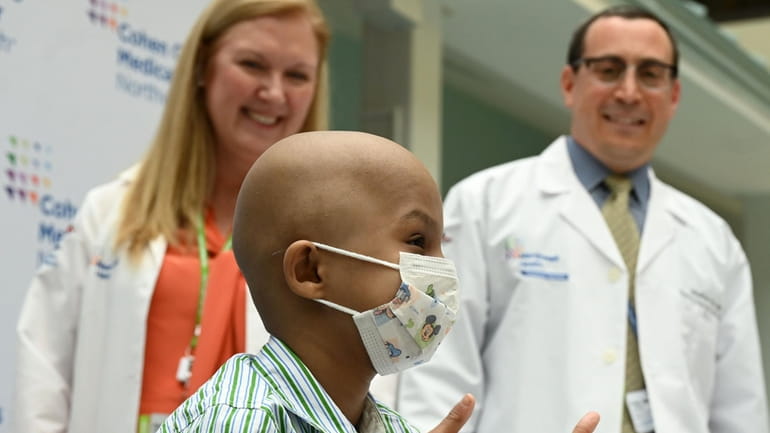Long Island boy, 8, is first in NYS to receive new therapy for blood disorder

Yusef Saeed, 8, gives a thumbs-up after speaking at a news conference Thursday about his successful treatment at Cohen Children’s Hospital in New Hyde Park with his doctor, Banu Aygun, left, and Dr. Jon Fish, head of stem cell transplant and cellular therapy. Credit: Danielle Silverman
An 8-year-old Long Island boy born with a genetic blood condition was the first person in New York to receive a “promising” treatment that has so far enabled him to stop the frequent blood transfusions vital to keeping him healthy.
Yusef Saeed, of Valley Stream, received on Jan. 9 an infusion of Zynteglo gene therapy at Cohen Children's Medical Center in Queens to treat his transfusion-dependent thalassemia — a genetic disease of the red blood cells.
People with a severe form of thalassemia can have severe anemia and need blood transfusions every few weeks, physicians said. The condition can also be potentially cured with a bone marrow transplant procedure, but that requires the sometimes arduous process of finding a donor, as well as possible rejection.
But more than two months after his treatment, Yusef sat in the atrium of Northwell Health’s Cohen Children's Medical Center. He has not needed a blood transfusion since getting the treatment.
Around him, physicians and his parents praised the Zynteglo gene therapy as transformative.
“I think that gene therapy really is a treatment that will expand dramatically over the next decade,” Dr. Jonathan Fish, who heads the hospital's stem cell transplant and cellular therapy, said at a news conference.
Dr. Banu Aygun, the associate chief of hematology who first started seeing Yusef when he was a month old, said Wednesday that seeing him get the therapy is rewarding both professionally and personally.
“It's priceless,” she said. “I’m so happy for him and his family because I know they have been waiting for this since he was diagnosed.”
Dr. Lakshmanan Krishnamurti, pediatrics professor and chief of pediatric hematology, oncology, and bone marrow transplant at Yale School of Medicine, agreed that the therapy has “promise” for thalassemia patients, noting that it could improve their quality of life.
But he also said the treatment is not without hindrances, including cost, undergoing chemotherapy and potential unknown long-term impacts.
“So it's certainly an option that … should be offered,” said Krishnamurti, who was not at the news conference. “People should be educated about it.”
The Cohen Children's Medical Center said they are actively treating patients with the therapy. The Mount Sinai Health System said it is working toward making these gene therapy treatments available for thalassemia.
The inherited disorder is caused by the body producing insufficient amounts of hemoglobin, which impacts how red blood cells function, the Centers for Disease Control and Prevention said. It can lead to severe anemia, which can be deadly, the CDC said.
Many children in the United States are diagnosed in infancy because of genetic testing done on babies, physicians said. But outside of the United States, some children are only diagnosed when they develop severe anemia.
Even before Yusef was born, his mother, Yusara Ahmed, 35, was familiar with thalassemia.
Her sister was diagnosed with the condition and had received a bone marrow transplant after her brother was found to be a match.
Yusef's twin sister was not a match, so the boy started blood transfusions every few weeks. But transfusions have their own issues, including an iron overload that damages the body’s organs. Patients take medication to take some of the iron out of the body.
Then there is the practical side of bringing an infant, toddler and then school-age child frequently to a hospital to get blood transfusions.
That was the situation with Yusef until doctors told the family about Zynteglo — and the family decided to take a chance on the treatment. The Zynteglo gene therapy treatment involves several steps that include taking the patient’s stem cells and sending them to a manufacturing site to make the Zynteglo, Northwell Health said.
Yusef also had to take chemotherapy to wipe out his bone marrow cells to make room for the new Zynteglo cells.
After that, he was given the treatment and waited for new blood cells to grow, which took about four to five weeks, during which he was hospitalized.
Ahmed said there were times she could see the emotional toll the process had on her son, particularly when he missed his sister.
Today, Yusef is back to his old self. He’s still shy, his mother said, but playful.
“[I’m] just very relieved and happy that we’re back to ... a more normal setting” and a normal life, Ahmed said.
Updated 6 minutes ago SBU students protest ... Plea in crash that killed 4 ... Westbury streetscaping begins ... World's 'Flair'
Updated 6 minutes ago SBU students protest ... Plea in crash that killed 4 ... Westbury streetscaping begins ... World's 'Flair'

